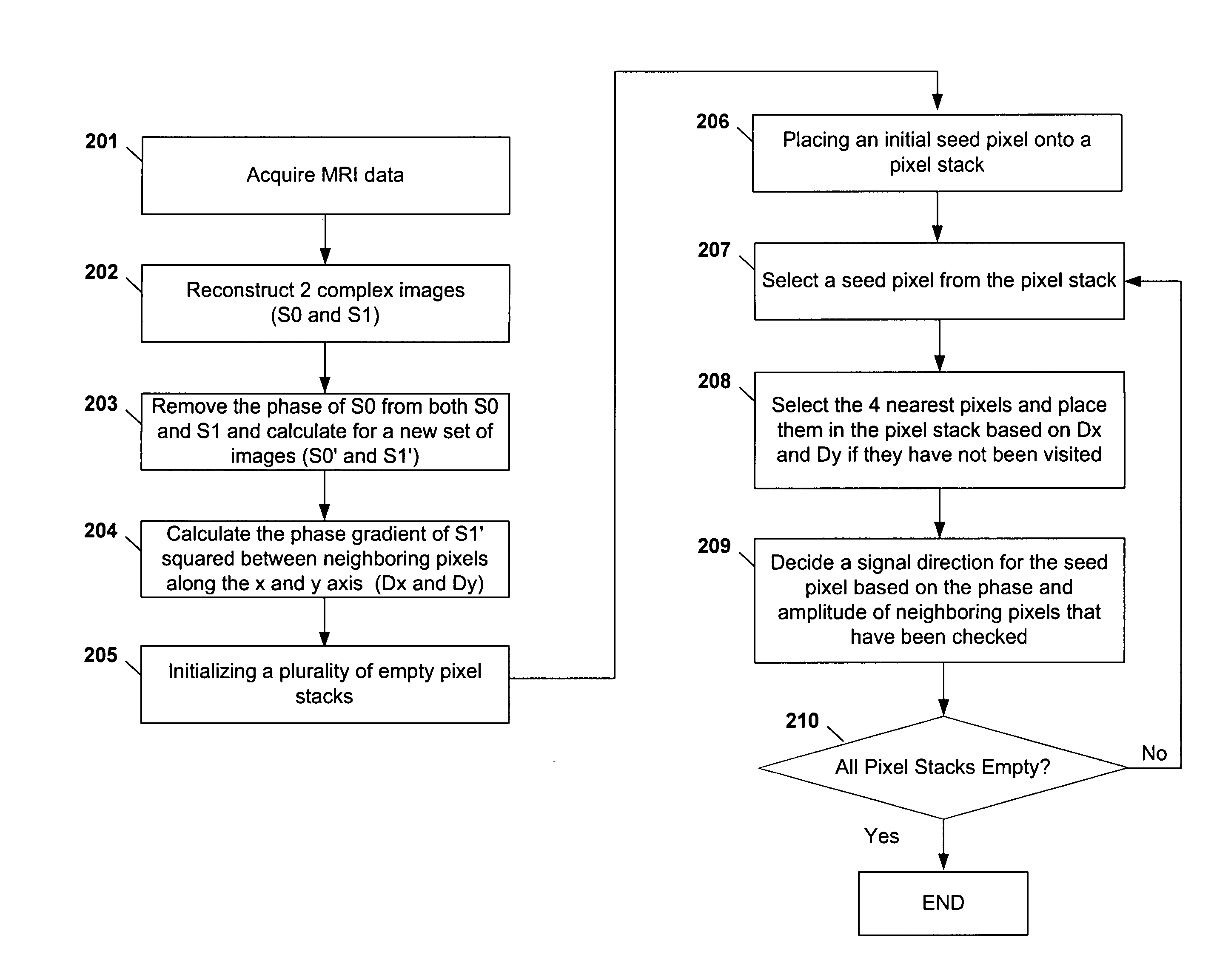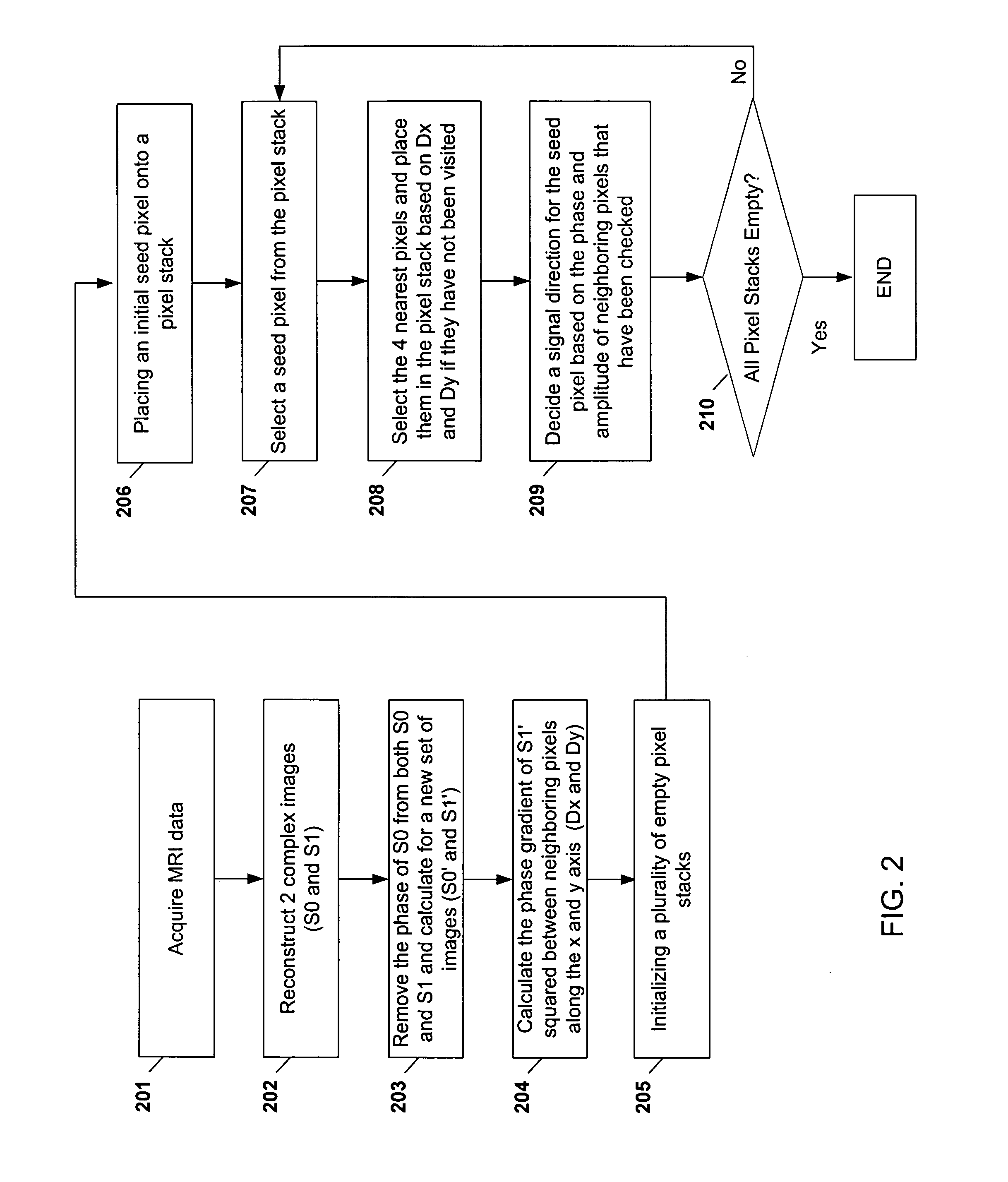Method and apparatus for phase-sensitive magnetic resonance imaging
a phase-sensitive magnetic resonance and imaging technology, applied in the field of medical imaging, can solve the problems of not always realizing the potential for increasing tissue contrast by ir imaging, reducing or even reversed the contrast in an ir image, and lacking the true reliable and automated phase correction method, etc., to achieve the effect of maintaining consistency and maintaining polarity consistency
- Summary
- Abstract
- Description
- Claims
- Application Information
AI Technical Summary
Benefits of technology
Problems solved by technology
Method used
Image
Examples
example 1
Reconstructing Images Using a 2-point Dixon Technique
[0085] As shown in FIGS. 6A-6D and FIGS. 7A-7B, the resulting images are from the reconstruction and phase correcting methods. The images are from abdominal examinations using 1.5 Tesla MRI scanners and a four-channel torso phased-array receiver coil. In one embodiment, the scanning protocol may include: a sequence repetition time of 150 ms, an echo time (TE) of 2.2 ms for opposed-phase images, an TE of 4.7 ms for in-phase images, a receiver bandwidth of ±62.5 KHz, an acquisition matrix of 256×192 pixels, a field of view of 36×cm, a slice thickness of 5-7 mm, and a gap of 0-1 mm. The protocol may generate approximately 20 slices collected within 20s. Thus, the entire abdomen may be scanned in one or two breath holds.
[0086] In one embodiment of the invention, the reconstruction of the water-only and fat-only images may be performed offline using an IBM ThinkPad PC with an Intel processor (e.g., x86 family operating at approximat...
example 2
Phase Sensitive Inversion Recovery Imaging of Multi-slice and Multi-coil Data
[0093] As noted above, phase-sensitive inversion recover (PSIR) image reconstruction scheme uses both the magnitude and the phase information of the signals for phase correction. The phase correction component may be extended and optimized from a region growing scheme for Dixon water and fat chemical shift imaging. The methods provided by example require neither selection of an empirical phase threshold nor explicit use of a special phase filter. Further, the global polarity of images from different receiver coils and from different slices may be made consistent by exploiting the inter-coil and inter-slice correlation intrinsic to the original complex images.
[0094] Referring to FIG. 8, a system 800 including MR scanner 801 such as the General Electric Signa 3.0 Tesla whole-body MR scanner (GE Healthcare, Waukesha, Wis.) using an IR fast spin-echo pulse sequence and head coil 802 such as an 8-channel phas...
example 3
Improving Signal-to-Noise in Multi-slice and Multi-coil Data
[0099] To increase the signal-to-noise ratio (SNR) and / or increase imaging speed, data acquisition in MR imaging is increasingly performed using multiple receiver coils. For image reconstruction methods, such as phase sensitive inversion recovery (PSIR), the images from the multiple receiver coils contain both positive and negative values after a successful phase correction. In order to produce a final image, the images from the different receiver coils must be combined.
[0100] According to an embodiment of the present invention, the polarity of the images from one slice of all the different receiver coils is checked for consistency. Referring to FIGS. 12A-12H, the images are from one particular slice but from 8 different receiver coils. These images are a result of a phase correction, but only FIGS. 12B, 12E, and 12H have the correct polarities. As such, the polarities of the images are altered for consistency. The sum o...
PUM
 Login to View More
Login to View More Abstract
Description
Claims
Application Information
 Login to View More
Login to View More - R&D
- Intellectual Property
- Life Sciences
- Materials
- Tech Scout
- Unparalleled Data Quality
- Higher Quality Content
- 60% Fewer Hallucinations
Browse by: Latest US Patents, China's latest patents, Technical Efficacy Thesaurus, Application Domain, Technology Topic, Popular Technical Reports.
© 2025 PatSnap. All rights reserved.Legal|Privacy policy|Modern Slavery Act Transparency Statement|Sitemap|About US| Contact US: help@patsnap.com



